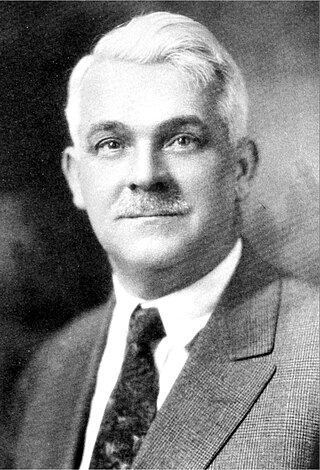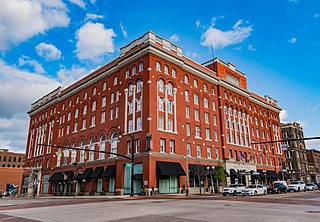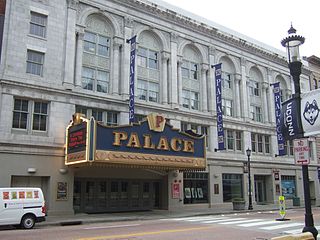
Thomas White Lamb was a Scottish-born, American architect. He was one of the foremost designers of theaters and cinemas of the 20th century.

The Victory Theatre is a 1,950-seat venue in Evansville, Indiana. It is home to the Evansville Philharmonic Orchestra and also hosts local ballet and modern dance companies, theatre companies, and touring productions.

The Palace Theatre is a stage production venue at 76-96 Hanover Street in Manchester, New Hampshire, United States. Built in 1914, the theatre was listed on the National Register of Historic Places as the Athens Building.

The Landmark Theatre, originally known as Loew's State Theater, is a historic theater from the era of movie palaces, located on South Salina Street in Syracuse, New York, United States. Designed by Thomas W. Lamb, it is the city's only surviving example of the opulent theatrical venues of the 1920s. The Landmark is on the National Register of Historic Places.

The Greensburg Downtown Historic District of Greensburg, Pennsylvania, is bounded approximately by Tunnel Street, Main Street, Third Street, and Harrison Avenue. It consists of 62 buildings on 21.8 acres (8.8 ha), with the most notable buildings from the years 1872-1930. The district's oldest structure (1872) is the former Masonic Temple at 132 South Main Street. The Academy Hill Historic District is directly to the north of downtown Greensburg.

The Broadway Theater District in the Historic Core of Downtown Los Angeles is the first and largest historic theater district listed on the National Register of Historic Places (NRHP). With twelve movie palaces located along a six-block stretch of Broadway, it is the only large concentration of movie palaces left in the United States. The same six-block stretch of Broadway, and an adjacent section of Seventh Street, was also the city's retail hub for the first half of the twentieth century, lined with large and small department stores and specialty stores.

The Hippodrome Theatre is a theater in Baltimore, Maryland.

The Monroe Avenue Commercial Buildings, also known as the Monroe Block, is a historic district located along a block-and-a-half stretch at 16-118 Monroe Avenue in Detroit, Michigan, just off Woodward Avenue at the northern end of Campus Martius. The district was designated a Michigan State Historic Site in 1974 and listed on the National Register of Historic Places in 1975. The thirteen original buildings were built between 1852 and 1911 and ranged from two to five stories in height. The National Theatre, built in 1911, was the oldest surviving theatre in Detroit, a part of the city's original theatre district of the late 19th century, and the sole surviving structure from the original Monroe Avenue Commercial Buildings historic period.

The Great Southern Hotel & Theatre is an historic hotel and theater building in Downtown Columbus, Ohio. The building currently operates as the Westin Great Southern Columbus and the Southern Theatre.

The Hanover Theatre and Conservatory for the Performing Arts is a complex in Worcester, Massachusetts, that includes an auditorium, where touring acts perform regularly, and several classrooms that host classes relating to the arts.

The Majestic Theatre is a performing arts theater in the City Center District of Downtown Dallas. It is the last remnant of Theater Row, the city's historic entertainment center on Elm Street, and is a contributing property in the Harwood Street Historic District. The structure is a Dallas Landmark and is listed on the National Register of Historic Places.

Saint Benedict - Our Lady of Montserrat, or simply St. Benedict's Church, is a Catholic church in Stamford, Connecticut, in the Diocese of Bridgeport. The historic brick Neo-Tudor church at 1A St. Benedict's Circle was built in 1930 and added to the National Register of Historic Places in 1987. The architect was Henry F. Ludorf of Hartford, Connecticut. The exterior uses a variety of building materials, including brick, ashlar stone, timbering, and stucco. The church's main facade is asymmetrically arranged with its entrance on the left, under a handsome timber-frame porch, and a stone tower to the right which is topped by a bellpot roof.

The Fairfield County Courthouse, also known as the Court of Common Pleas, is located at 172 Golden Hill Street in downtown Bridgeport, Connecticut. It is also known as Geographical Area (GA) Courthouse No. 2 at Bridgeport. It is a Richardsonian Romanesque brick building built in 1888. It was listed on the National Register of Historic Places in 1982. It still functions as a courthouse where all but the most serious criminal cases are heard.

The Bridgeport Downtown North Historic District encompasses a portion of the commercial downtown of Bridgeport, Connecticut. It is roughly bounded on the north by Congress Street, the east by Water and Middle Streets, the south by Fairfield Avenue, and the west by Lyon Terrace, roughly the northeastern quadrant of the downtown area. It is one of two large clusters of historically significant commercial and civic buildings encapsulating the city's growth as an urban industrial and regional government center. It was listed on the National Register of Historic Places in 1987.

The Hotel Beach, also known historically as the Hotel Barnum, is a historic hotel building at 140 Fairfield Ave. in Bridgeport, Connecticut. It is a thirteen-story Art Deco tower built in 1927 and designed by Thomas, Martin & Kirkpatrick. It is one of the city's outstanding Art Deco buildings, built when the city was at its peak. It was listed on the National Register of Historic Places in 1978. It is a contributing building in the Bridgeport Downtown North Historic District, NRHP-listed in 1987. It is currently a residential apartment building called Barnum House.

Sylvester Zefferino Poli was an Italian immigrant to the USA who became a theatre magnate during the late 19th-century and early decades of the 20th century. By 1916 he controlled 30 theatres, and was heralded as the largest individual theatre owner in the world at that time, establishing himself throughout the Northeastern United States. Starting with a career in wax sculpting, he quickly moved on to dime museums, curios, variety shows, and ultimately vaudeville theatres and movie palaces.

Loew's Theatre is a historic movie theater located on Main Street in the Downtown section of the city of New Rochelle in Westchester County, New York.

The Burritt Hotel was a historic hotel at 67 West Main Street in New Britain, Connecticut, United States. Built in the 1920s to attract business travelers, it was the city's most luxurious hotel. It is now Burritt House, an affordable housing complex. The building was listed on the National Register of Historic Places in 1983.

The New Britain Opera House, also known as the Palace Theater, was a performance venue and movie house on Main Street in downtown New Britain, Connecticut. Built in 1880, it was a prominent local example of Renaissance Revival architecture, serving as an entertainment venue for about a century. It was listed on the National Register of Historic Places in 1977. It has since been demolished as part of local urban renewal.

The Palace Theater is a 2,900-seat auditorium at 100 East Main Street in downtown Waterbury, Connecticut. The theater currently presents a variety of live entertainment, hosting traveling productions and locally produced events. It was built in 1921 to a Renaissance Revival design by Thomas W. Lamb, and is an architecturally prominent element of the city's downtown. It underwent a major restoration in the early 21st century, and is listed on the National Register of Historic Places.






















